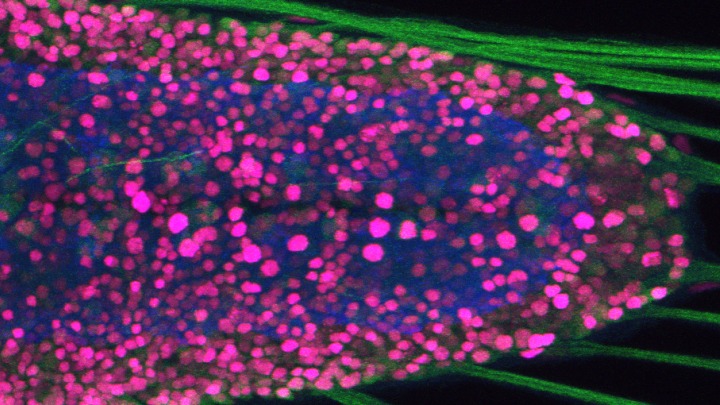
No pain, no gain: investigating how painful experiences change neural circuits and behavior

As children we learn through painful experience not to touch a hot stove or to run with our shoe laces untied. Now research led by the University of Michigan Life Sciences Institute is shedding new light on long-lasting changes that painful stimuli can exert at the level of a neural circuit — changes that can have a powerful impact on behavior.
The scientists developed a novel system for analyzing how fruit-fly larvae adapt to irritating stimuli. Their findings were published July 13 in Neuron, a leading neuroscience journal.
“Fruit-fly larvae respond to noxious stimuli by curling up and rolling away,” says lead study author Takuya Kaneko, a graduate student working in the lab of LSI faculty member Bing Ye, Ph.D. “This behavior decreases by over 80 percent in mature larvae when their nociceptive — or pain-sensing — neurons are stimulated during development. And our experiments elucidated a feedback mechanism that dampens this signal.”
The research group, which included collaborators from Northern Illinois University and Duke University Medical School, further showed that even though pain signals and touch sensations are routed to the same downstream neurons, the larvae’s response to mechanical stimulation remained unchanged.
“You can see why it would be useful for an organism to decrease its sensitivity to a noxiously hot environment without diminishing its sense of touch,” says Ye, the study’s senior author and also an associate professor of cell and developmental biology at the U-M Medical School. “These flies live all over the world, from Scandinavian countries to the equator. Their genetic programming is the same, so they need a way to individually adjust to many different types of environmental challenges — such as high temperatures or chemicals plants use to keep insects away.”
The ability of neural circuits to change in response to shifting conditions is called plasticity, Ye notes.
“Here we were able to show for the first time that fruit flies have this sensory-pathway-specific plasticity,” he adds. “And this model can be used to further study how different types of sensory stimulation during development can lead to changes in a mature organism.”
Drosophila — the scientific name for fruit flies —are a commonly used model organism for studying fundamental biological processes. There are many reasons for this, among them their well-mapped genome and neural circuitry, the ease of conducting experiments involving genetic manipulation, the surprising amount their biology is preserved in more complex organisms, and the speed of their lifecycle.
Go to Article
Serotonergic modulation enables pathway-specific plasticity in a developing sensory circuit in Drosophila, Neuron. DOI: 10.1016/j.neuron.2017.06.034


